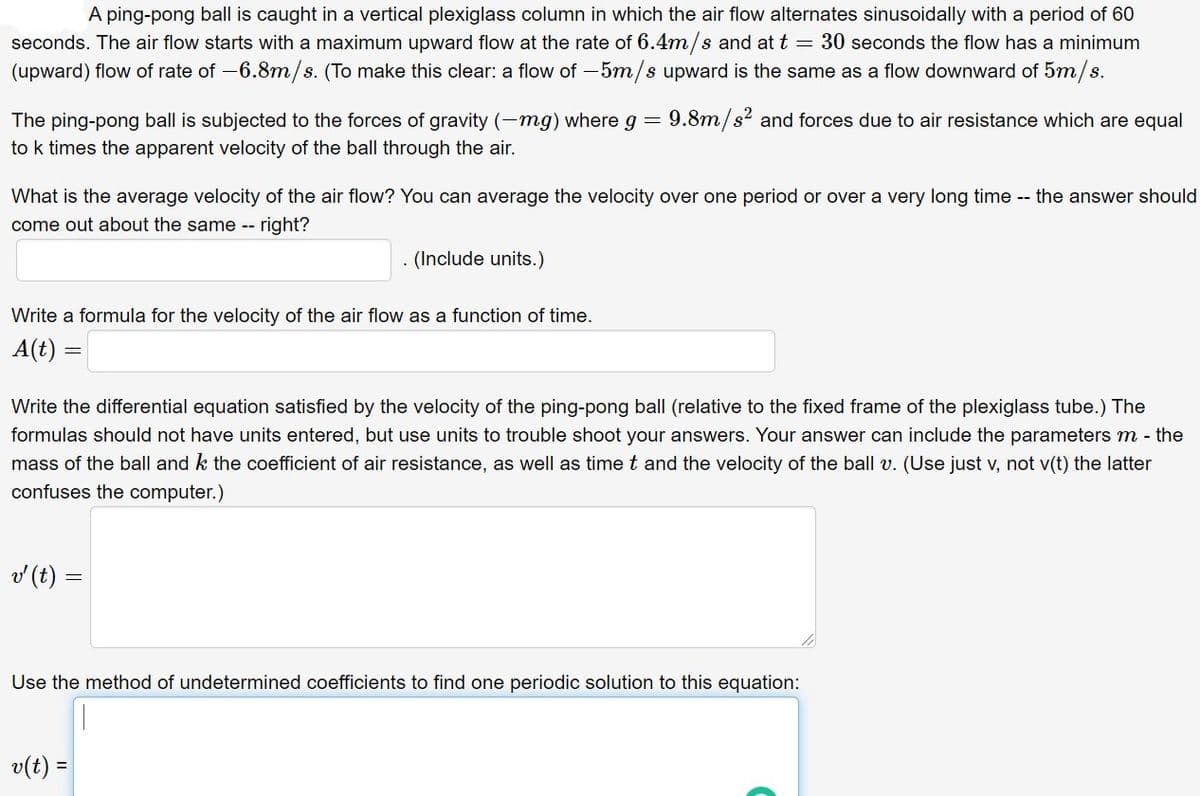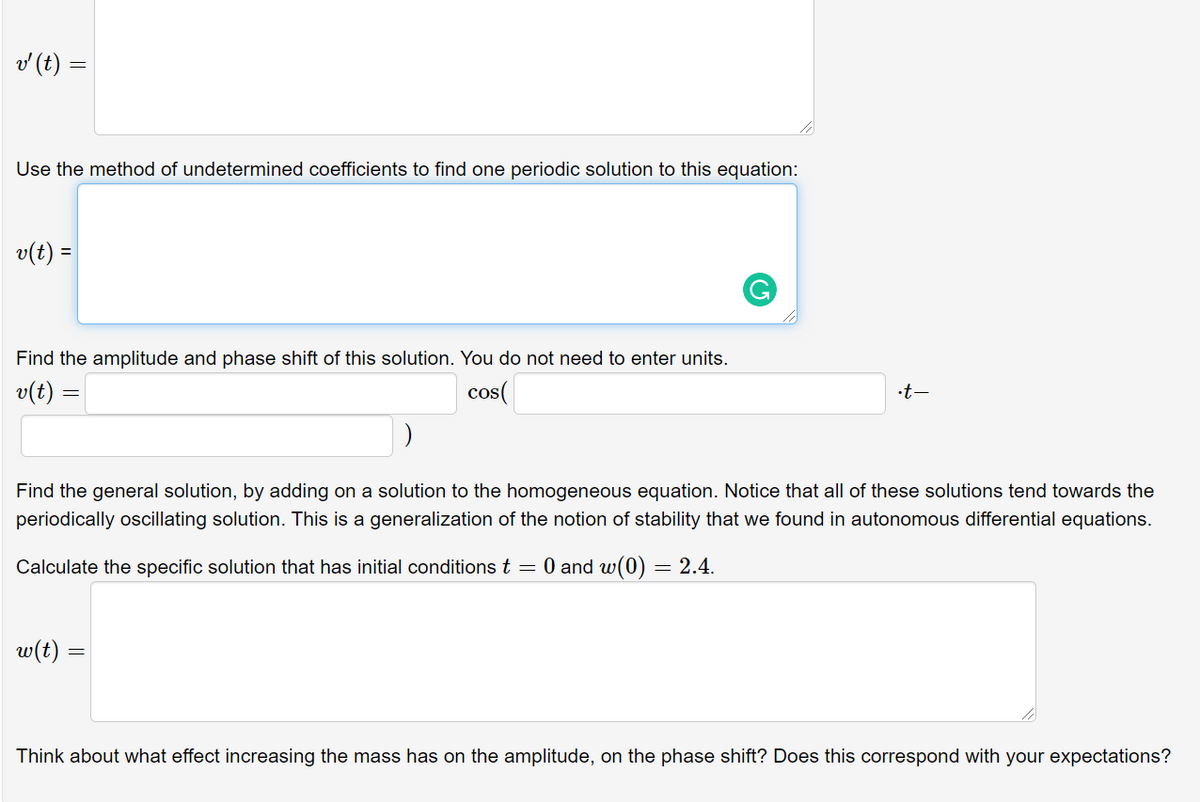A ping-pong ball is caught in a vertical plexigiass column in which the air flow alternates sinusoidally with a period of 60 seconds. The air flow starts with a maximum upward flow at the rate of 6.4m/s and at t = 30 seconds the flow has a minimum (upward) flow of rate of -6.8m/s. (To make this clear: a flow of -5m/s upward is the same as a flow downward of 5m/s. 9.8m/s? and forces due to air resistance which are equal The ping-pong ball is subjected to the forces of gravity (-mg) where g = to k times the apparent velocity of the ball through the air. What is the average velocity of the air flow? You can average the velocity over one period or over a very long time - the answer should come out about the same -- right? . (Include units.) Write a formula for the velocity of the air flow as a function of time. A(t) = Write the differential equation satisfied by the velocity of the ping-pong ball (relative to the fixed frame of the plexiglass tube.) The formulas should not have units entered, but use units to trouble shoot your answers. Your answer can include the parameters m - the mass of the ball and k the coefficient of air resistance, as well as time t and the velocity of the ball v. (Use just v, not v(t) the latter
A ping-pong ball is caught in a vertical plexigiass column in which the air flow alternates sinusoidally with a period of 60 seconds. The air flow starts with a maximum upward flow at the rate of 6.4m/s and at t = 30 seconds the flow has a minimum (upward) flow of rate of -6.8m/s. (To make this clear: a flow of -5m/s upward is the same as a flow downward of 5m/s. 9.8m/s? and forces due to air resistance which are equal The ping-pong ball is subjected to the forces of gravity (-mg) where g = to k times the apparent velocity of the ball through the air. What is the average velocity of the air flow? You can average the velocity over one period or over a very long time - the answer should come out about the same -- right? . (Include units.) Write a formula for the velocity of the air flow as a function of time. A(t) = Write the differential equation satisfied by the velocity of the ping-pong ball (relative to the fixed frame of the plexiglass tube.) The formulas should not have units entered, but use units to trouble shoot your answers. Your answer can include the parameters m - the mass of the ball and k the coefficient of air resistance, as well as time t and the velocity of the ball v. (Use just v, not v(t) the latter
Functions and Change: A Modeling Approach to College Algebra (MindTap Course List)
6th Edition
ISBN:9781337111348
Author:Bruce Crauder, Benny Evans, Alan Noell
Publisher:Bruce Crauder, Benny Evans, Alan Noell
Chapter2: Graphical And Tabular Analysis
Section2.1: Tables And Trends
Problem 1TU: If a coffee filter is dropped, its velocity after t seconds is given by v(t)=4(10.0003t) feet per...
Related questions
Question

Transcribed Image Text:A ping-pong ball is caught in a vertical plexiglass column in which the air flow alternates sinusoidally with a period of 60
seconds. The air flow starts with a maximum upward flow at the rate of 6.4m/s and at t = 30 seconds the flow has a minimum
(upward) flow of rate of -6.8m/s. (To make this clear: a flow of - 5m/s upward is the same as a flow downward of 5m/s.
The ping-pong ball is subjected to the forces of gravity (-mg) where g
9.8m/s2 and forces due to air resistance which are equal
to k times the apparent velocity of the ball through the air.
What is the average velocity of the air flow? You can average the velocity over one period or over a very long time -- the answer should
come out about the same -- right?
. (Include units.)
Write a formula for the velocity of the air flow as a function of time.
A(t) =
Write the differential equation satisfied by the velocity of the ping-pong ball (relative to the fixed frame of the plexiglass tube.) The
formulas should not have units entered, but use units to trouble shoot your answers. Your answer can include the parameters m - the
mass of the ball and k the coefficient of air resistance, as well as time t and the velocity of the ball v. (Use just v, not v(t) the latter
confuses the computer.)
v (t) =
Use the method of undetermined coefficients to find one periodic solution to this equation:
v(t) =

Transcribed Image Text:v (t) =
Use the method of undetermined coefficients to find one periodic solution to this equation:
v(t) =
Find the amplitude and phase shift of this solution. You do not need to enter units.
v(t) =
cos(
•t-
Find the general solution, by adding on a solution to the homogeneous equation. Notice that all of these solutions tend towards the
periodically oscillating solution. This is a generalization of the notion of stability that we found in autonomous differential equations.
Calculate the specific solution that has initial conditions t = 0 and w(0) = 2.4.
w(t)
Think about what effect increasing the mass has on the amplitude, on the phase shift? Does this correspond with your expectations?
Expert Solution
This question has been solved!
Explore an expertly crafted, step-by-step solution for a thorough understanding of key concepts.
This is a popular solution!
Trending now
This is a popular solution!
Step by step
Solved in 3 steps

Knowledge Booster
Learn more about
Need a deep-dive on the concept behind this application? Look no further. Learn more about this topic, advanced-math and related others by exploring similar questions and additional content below.Recommended textbooks for you

Functions and Change: A Modeling Approach to Coll…
Algebra
ISBN:
9781337111348
Author:
Bruce Crauder, Benny Evans, Alan Noell
Publisher:
Cengage Learning


Linear Algebra: A Modern Introduction
Algebra
ISBN:
9781285463247
Author:
David Poole
Publisher:
Cengage Learning

Functions and Change: A Modeling Approach to Coll…
Algebra
ISBN:
9781337111348
Author:
Bruce Crauder, Benny Evans, Alan Noell
Publisher:
Cengage Learning


Linear Algebra: A Modern Introduction
Algebra
ISBN:
9781285463247
Author:
David Poole
Publisher:
Cengage Learning

Trigonometry (MindTap Course List)
Trigonometry
ISBN:
9781337278461
Author:
Ron Larson
Publisher:
Cengage Learning